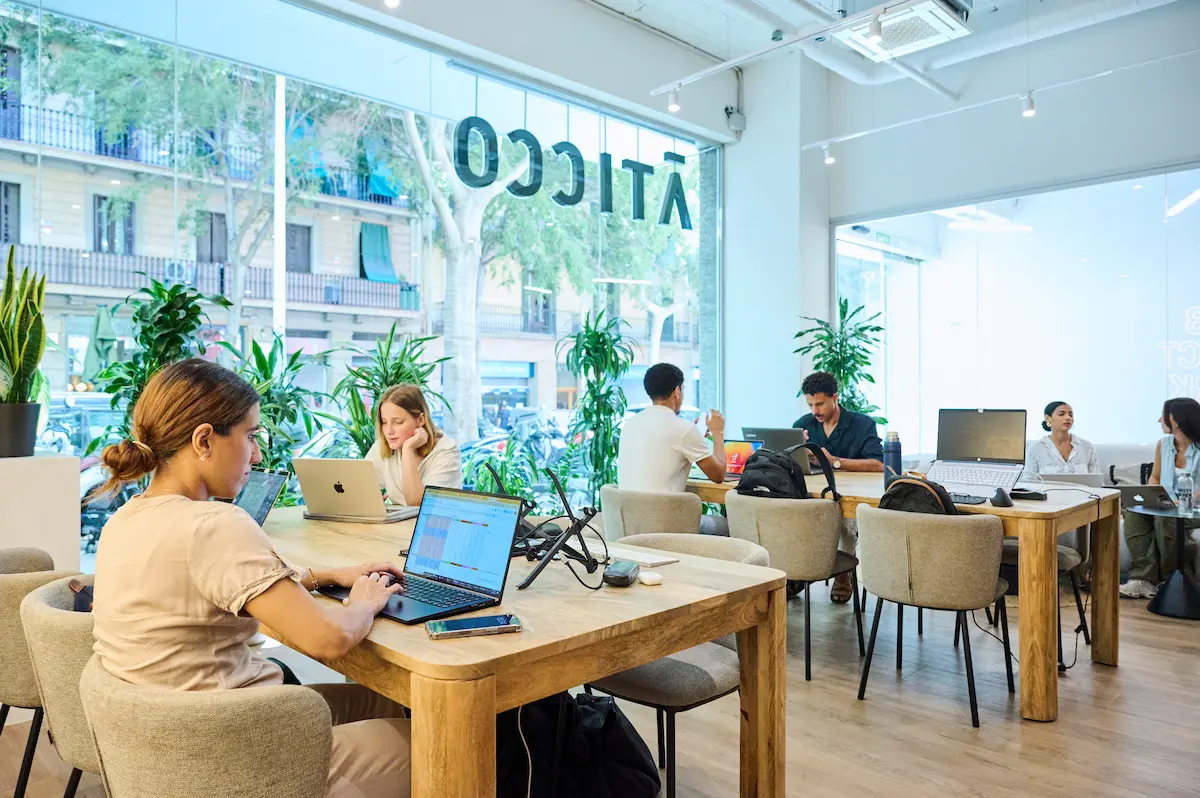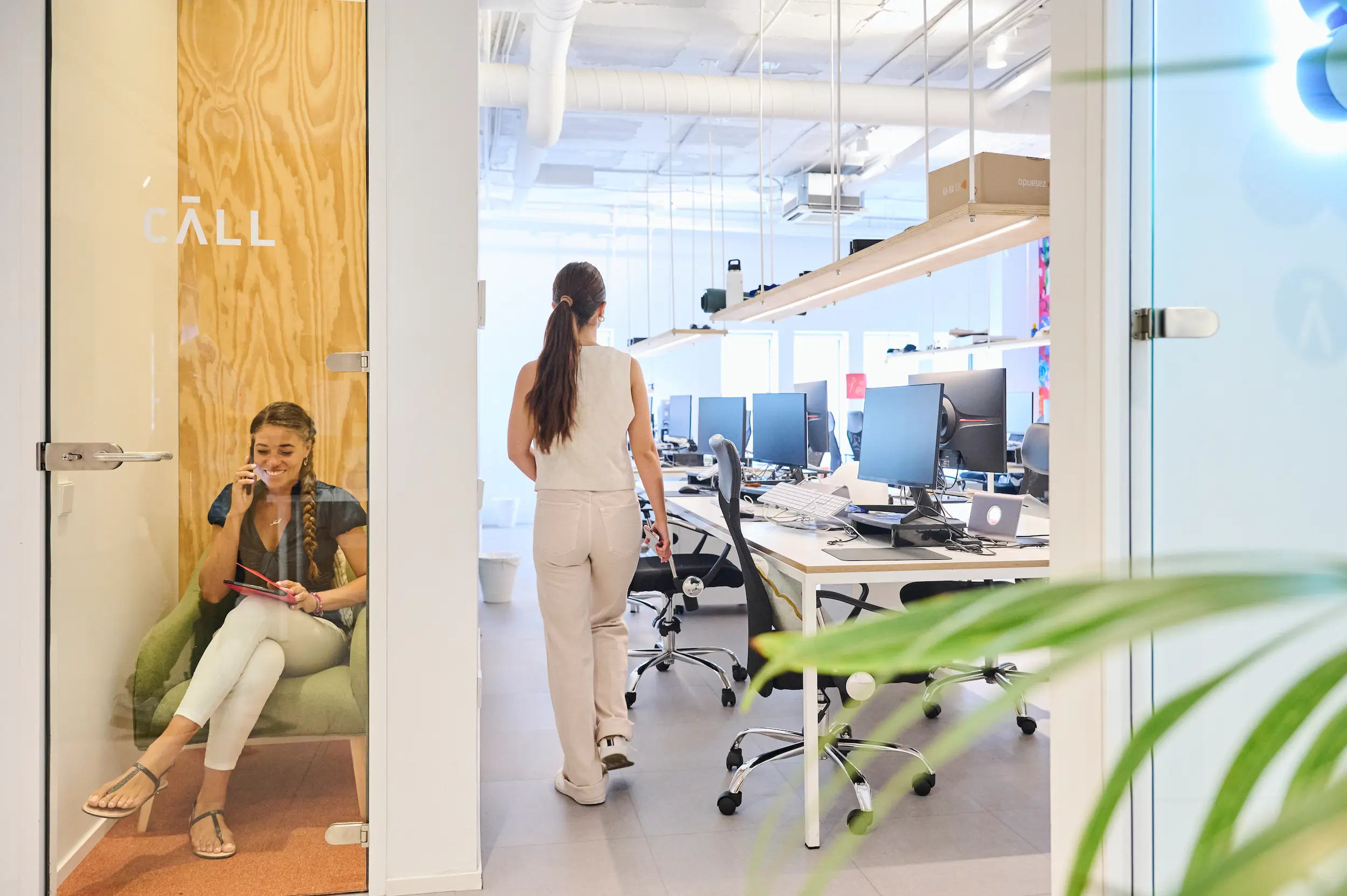What is collaborative work and what are its main characteristics

Collaborative work is a work modality in which a group of individuals with different skills, knowledge, and experiences come together to achieve a common goal jointly and in a coordinated manner. In this modality, effective communication and the contribution of all team members are fundamental, as its objective is to promote innovation, problem-solving, and continuous improvement by leveraging the strengths and different perspectives that the members bring.
Here we tell you everything you need to know about collaborative work and why you should implement it in your organization.
Types of collaborative work that exist
This work model can be implemented in each organization in different ways, depending on the projects they are developing, the team profile, and the objectives they seek to achieve. Some of the most common types of collaborative work are:
- Brainstorming
These are work sessions in which a specific problem or need is raised with the aim of obtaining innovative ideas to solve it. The premise of a brainstorming session is to give creative freedom to all participants to share everything that occurs to them and foster a dynamic of constructive feedback to reach a conclusion together. - Waterfall work
It is a type of collaborative work in which tasks are performed in a sequential order. That is, one team member starts by performing a task that another member continues, and so on until the project is finished. In this case, each phase depends on the completion of the previous one, and the contribution that each individual makes from their particular perspective and skills is valued. - Parallel work
Unlike waterfall work, in parallel work the tasks that each team member performs can be worked on simultaneously, that is, there is no need to finish one task to start another. This type of work requires more thorough monitoring to detect new areas of opportunity, but at a general level, reaching a conclusion is a more accelerated process. - Remote collaboration
Remote work and hybrid models have brought with them new processes to facilitate collaborative work despite the distance. Today, there are different digital tools that allow people to collaborate on projects online, even from different parts of the world. - Co-creation
This type of collaboration is mainly used in processes where the objective is to design a new product, service or solution. In this case, members from more than one work team participate, that is, the ideas of the different interested parties are shared (various departments of the same organization, clients and suppliers, etc.).
Advantages of collaborative work
Collaboration has multiple benefits, both for individuals who carry out projects with this work modality, and for companies that decide to implement it. Some of its main advantages are:
- Encourages creativity and innovation
The exchange of information and knowledge, as well as the combination of different perspectives and skills, can help improve the team's creative capacity and lead to more original ideas. Holding brainstorming sessions is a great opportunity to take advantage of this benefit of collaborative work. - Facilitates problem-solving
As they say, "two heads are better than one," and having more than one perspective to approach a problem is certainly a good strategy for finding effective solutions more easily. In addition, collaborative work is very useful when facing problems that would be very difficult to solve individually. - Increases motivation and sense of belonging
Working towards a common goal, as well as sharing achievements, helps increase the motivation of workers by making them feel part of a collective effort. This also encourages integration and a sense of belonging, both within work teams and in the company in general. - Promotes productivity and efficiency
Collaborative work helps facilitate decision-making and optimize the distribution of tasks, taking into account individual strengths and skills, which allows workdays to be more efficient and goals to be achieved more easily. - Promotes learning and multidisciplinary work
Collaboration brings together people with different knowledge, skills, and professional profiles, which not only helps to obtain better results, but also makes the work more enriching for team members. - Stimulate coexistence and interpersonal relationships
Collaborative work dynamics favor constant interaction between workers, which helps to strengthen relationships both personally and professionally, especially in those teams that perform remote work. In addition, a collaborative team promotes effective communication, negotiation and conflict resolution skills, which improves interpersonal relationships.
Differences Between Collaborative, Cooperative, and Team Work
At first, it might seem that these three terms have the same meaning and can be used as synonyms, however, they have different nuances both in their meaning and in their implementation as work models. The main characteristics that define each one are:
Collaborative work
This model is used when a group of individuals with different skills and professional profiles work together towards a common goal.
In this case, there is a horizontal organization within the group, and the distribution of tasks is based on an equitable contribution from all members. Similarly, although each individual contributes their particular experience and skills, constant learning is encouraged, as well as the generation of ideas and creative solutions from the combination of everyone's perspectives.
Cooperative work
This term refers to carrying out a project as a group, where participants divide the tasks, but each one works on their part independently.
In teams that use this working model, members may have separate tasks whose results are focused on a common goal, but despite this goal, there is less interdependence within the group, compared to collaborative work.
Teamwork
Teamwork implies that all members work together in a coordinated and cohesive manner to achieve a shared goal.
In this work model, the organization of tasks is carried out vertically, taking into account the structure of the organization and the profile of each participant within it. Although each member has their own tasks, effective communication and synergy between all members is essential for successful teamwork.
Key ways to improve teamwork collaboration
Collaborative work is essential to promote efficiency and innovation in an organization, as well as the quality of work and the commitment of its members. However, to maximize the effectiveness of this model and take greater advantage of its benefits, it is important to optimize processes and workflow within the group. Some keys to doing so are:
- Establish clear and measurable objectives, and communicate them to the team. All members must understand what they are trying to achieve.
- Generates an appropriate environment for group work, and creates an atmosphere of trust and respect that helps foster creative freedom and effective communication.
- Make sure you have a suitable physical space for day-to-day activities. Shared offices or coworking spaces usually offer areas that facilitate collaborative work.
- Implement the use of digital tools that favor workflow and collaboration. There are multiple project management platforms, as well as messaging and video conferencing systems that can help improve communication and work processes.
- Conduct a continuous evaluation of the work dynamic and foster a culture of feedback, where team members can give and receive constructive comments that help improve collaboration.
FREQUENTLY ASKED QUESTIONS ABOUT COLLABORATIVE WORK
Collaborative work offers great advantages for organizations, and its essential benefit lies in generating improvements in work results through synergy that is created when team members collaborate and value their different skills, knowledge, and perspectives to arrive at innovative and efficient solutions and ideas.
In addition, this work model promotes effective communication among team members and contributes to the creation of a positive and productive work environment within the organization.
How is collaborative work carried out?
To carry out collaborative work in your organization, the first thing you should consider is the objective you seek to achieve, since from it you can define the type of collaboration dynamic suitable for working around it.
To maintain effective collaboration during the workflow, you must ensure that you foster open and constant communication, provide regular monitoring and establish a system of continuous evaluation and feedback to ensure that the results are what you are looking for. In addition, we help you understand what team building means so you can start developing and implementing it within your company and improve the effectiveness of a work team.


